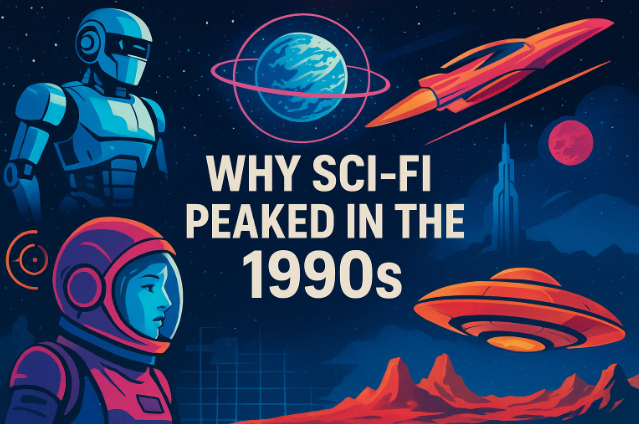
Science fiction is a genre centered on futuristic scientific progress, incorporating elements of information technology, robotics, biology, physics, chemistry, space exploration, time travel, parallel universes, and extraterrestrial life. In simple terms, it’s about creating a holographic experience of the impossible—turning imagined scientific advances into a tangible reality. This curiosity-driven genre has long inspired audiences to witness worlds beyond the possible.
The 1990s were a particularly rich era for science fiction. While its core subgenres had already been established in earlier decades, the 90s saw a technological and creative boom that pushed sci-fi into new territory—both in literature and cinema. Much of this momentum came from advances in technology that made storytelling more ambitious and immersive.
Key Sci-Fi Subgenres of the 1990s
Cyberpunk
Rooted in 1980s literature, cyberpunk explored advanced technology, virtual realities, and social inequality in gritty, dystopian urban settings. The 90s solidified its place in pop culture, with films like Blade Runner and The Matrix setting visual and thematic standards.
Space Opera
Grand tales of space exploration and interstellar conflict thrived in shows like Star Trek: The Next Generation and films like Star Trek VI: The Undiscovered Country. These works combined alien encounters with political and philosophical themes.
Hard Science Fiction
Focused on scientific realism and the consequences of technological advancement, hard sci-fi flourished in works like Greg Egan’s novels, which tackled complex topics in physics and astrophysics.
Post-Apocalyptic
Exploring worlds after catastrophic events—be it nuclear war, pandemics, or ecological collapse—this subgenre produced memorable films such as The Day After Tomorrow.
Uchronia (Alternate History)
This speculative genre asked: “What if history had gone differently?” Notable works included Robert Harris’s Fatherland (Nazi Germany wins WWII) and Philip K. Dick’s The Man in the High Castle.
Why the 90s Were a Golden Era for Sci-Fi
Technological Breakthroughs – The decade marked the transition from traditional special effects to digital CGI, giving filmmakers unprecedented power to create realistic worlds, creatures, and environments.
- Global Events as Inspiration – The end of the Cold War, economic shifts, and rapid globalization fueled fresh storylines and speculative themes.
- Genre Blending – Sci-fi intersected with horror, thriller, and fantasy, creating hybrid subgenres and attracting wider audiences.
- Cultural Momentum – Decades of quality science fiction novels built a strong foundation, ensuring that adaptations and original works resonated with audiences.
Iconic 1990s Sci-Fi Films
- Predator 2 (1990)
- Terminator 2: Judgment Day (1991)
- Jurassic Park (1993)
- Independence Day (1996)
- Men in Black (1997)
- Godzilla (1998)
Later works like Avatar, Interstellar, and Dune built on the visual and thematic groundwork laid in the 90s.
Sci-Fi in Tamil Literature and TV
In Tamil literature, S. Rangarajan (pen name Sujatha) brought science fiction to mainstream Tamil audiences with novels such as En Iniya Iyanthira, Meendum Jeeno, Kolaiyuthir Kaalam, and Computer Gramam. His short stories and essays also explored futuristic concepts, and he contributed as a screenwriter to films like Enthiran (2010).
On Tamil television, sci-fi elements appeared in anthology and thriller series such as Ragasiyam, Vidaathu Karuppu, Sorna Regai, Iyanthira Paravai, and Ethuvum Nadakum.
Iyanthira Paravai involved martial arts (Varma Kalai) and illegal activities linked to an information technology hub.
Ethuvum Nadakum explored the mythical Kalpa Vriksham tree, said to grant wishes, set against the backdrop of wildlife filmmaking.
